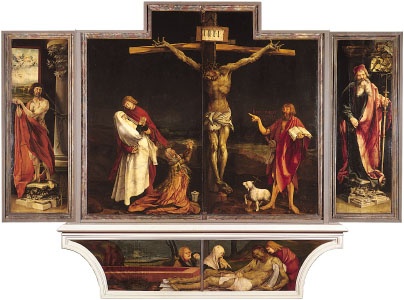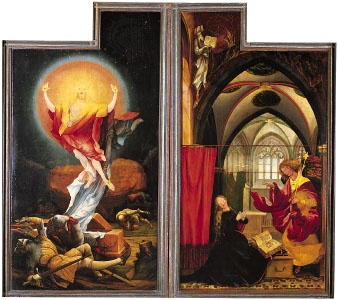Grünewald, Matthias
German artist
original name Mathis Gothardt
born c. 1480, Würzburg, bishopric of Würzburg 【Germany】
died August 1528, Halle, archbishopric of Magdeburg
one of the greatest German painters of his age, whose works on religious themes achieve a visionary expressiveness through intense colour and agitated line. The wings of the altarpiece of the Antonite monastery at Isenheim, in southern Alsace (dated 1515), are considered to be his masterpiece.
Although it is commonly agreed that “Master Mathis” was born in the German city of Würzburg, the date of his birth remains problematic. The first securely dated work by Grünewald (a name fabricated by a biographer in the 17th century; his actual surname was Gothardt), the Mocking of Christ of 1503, seems to be that of a young man just become a master. Grünewald appears first in documents of about 1500 either in the town of Seligenstadt am Main or Aschaffenburg. By about 1509 Grünewald had become court painter and later the leading art official (his title was supervisor or clerk of the works) to the elector of Mainz, the archbishop Uriel von Gemmingen.
About 1510 Grünewald received a commission from the Frankfurt merchant Jacob Heller to add two fixed wings to the altarpiece of the Assumption of the Virgin recently completed by the painter Albrecht Dürer (Dürer, Albrecht). These wings depicting four saints are painted in grisaille (shades of gray) and already show the artist at the height of his powers. Like Grünewald's drawings, which are done primarily in black chalk with some yellow or white highlighting, the Heller wings convey colouristic effects without the use of colour. Expressive hands and active draperies help blur the boundaries between cold stone and living form.
About 1515 Grünewald was entrusted with the largest and most important commission of his career. Guido Guersi, an Italian preceptor, or knight, who led the religious community of the Antonite monastery at Isenheim (in southern Alsace), asked the artist to paint a series of wings for the shrine of the high altar that had been carved in about 1505 by Niclaus Hagnower of Strasbourg. The subject matter of the wings of the Isenheim Altarpiece provided Grünewald's genius with its fullest expression and was based largely on the text of the popular, mystical Revelations of St. Bridget of Sweden (written about 1370).

 The Isenheim Altarpiece consists of a carved wooden shrine with one pair of fixed and two pairs of movable wings flanking it. Grünewald's paintings on these large wing panels consist of the following. The first set of panels depicts the Crucifixion, the Lamentation, and portraits of SS. Sebastian and Anthony. The second set focuses on the Virgin Mary, with scenes of the Annunciation (see photograph-->
The Isenheim Altarpiece consists of a carved wooden shrine with one pair of fixed and two pairs of movable wings flanking it. Grünewald's paintings on these large wing panels consist of the following. The first set of panels depicts the Crucifixion, the Lamentation, and portraits of SS. Sebastian and Anthony. The second set focuses on the Virgin Mary, with scenes of the Annunciation (see photograph--> ) and a Concert of Angels, a Nativity, and the Resurrection. The third set of wings focuses on St. Anthony, with St. Anthony and St. Paul in the Desert and the Temptation of St. Anthony.
) and a Concert of Angels, a Nativity, and the Resurrection. The third set of wings focuses on St. Anthony, with St. Anthony and St. Paul in the Desert and the Temptation of St. Anthony. The altarpiece's figures are given uniquely determined gestures, their limbs are distended for expressive effect, and their draperies (a trademark of Grünewald's that expand and contract in accordion pleats) mirror the passions of the soul. The colours used are simultaneously biting and brooding. The Isenheim Altarpiece expresses deep spiritual mysteries. The Concert of Angels, for instance, depicts an exotic angel choir housed within an elaborate baldachin. At one opening of the baldachin a small, glowing female form, the eternal and immaculate Virgin, kneels in adoration of her own earthly manifestation at the right. And at the far left of the same scene under the baldachin, a feathered creature, probably the evil archangel Lucifer, adds his demonic notes to the serenade. Other details in the altarpiece, including the horribly wounded body of Christ in the Crucifixion (see photograph-->
The altarpiece's figures are given uniquely determined gestures, their limbs are distended for expressive effect, and their draperies (a trademark of Grünewald's that expand and contract in accordion pleats) mirror the passions of the soul. The colours used are simultaneously biting and brooding. The Isenheim Altarpiece expresses deep spiritual mysteries. The Concert of Angels, for instance, depicts an exotic angel choir housed within an elaborate baldachin. At one opening of the baldachin a small, glowing female form, the eternal and immaculate Virgin, kneels in adoration of her own earthly manifestation at the right. And at the far left of the same scene under the baldachin, a feathered creature, probably the evil archangel Lucifer, adds his demonic notes to the serenade. Other details in the altarpiece, including the horribly wounded body of Christ in the Crucifixion (see photograph--> ), may refer to the role of the monastery as a hospital for victims of the plague and St. Anthony's fire. The colour red takes on unusual power and poignancy in the altarpiece, first in the Crucifixion, then in the Annunciation and Nativity, and finally on Christ's shroud in the Resurrection, which is at first lifeless in the cold tomb but which then smolders and bursts into white-hot flame as Christ ascends, displaying his tiny purified red wounds. Such transformations of light and colour are perhaps the most spectacular found in German art until the late 19th century. And through all this drama, Grünewald never misses the telling picturesque detail: a botanical specimen, a string of prayer beads, or a crystal carafe.
), may refer to the role of the monastery as a hospital for victims of the plague and St. Anthony's fire. The colour red takes on unusual power and poignancy in the altarpiece, first in the Crucifixion, then in the Annunciation and Nativity, and finally on Christ's shroud in the Resurrection, which is at first lifeless in the cold tomb but which then smolders and bursts into white-hot flame as Christ ascends, displaying his tiny purified red wounds. Such transformations of light and colour are perhaps the most spectacular found in German art until the late 19th century. And through all this drama, Grünewald never misses the telling picturesque detail: a botanical specimen, a string of prayer beads, or a crystal carafe.Another important clerical commission came from a canon in Aschaffenburg, Heinrich Reitzmann. As early as 1513 he had asked Grünewald to paint an altar for the Mariaschnee Chapel in the Church of Saints Peter and Alexander in Aschaffenburg. The artist painted this work in the years 1517–19. Grünewald apparently married about 1519, but the marriage does not appear to have brought him much happiness (at least, that is the tradition recorded in the 17th century). Grünewald occasionally added his wife's surname, Neithardt, to his own, thereby accounting for several documentary references to him as Mathis Neithardt or Mathis Gothardt Neithardt.
In 1514 Uriel von Gemmingen had died, and Albrecht von Brandenburg (Albert) had become the elector of Mainz. For Albrecht, Grünewald executed one of his most luxurious works, portraying The Meeting of SS. Erasmus and Maurice (Erasmus is actually a portrait of Albrecht). This work exhibits the theme of religious discussion or debate, so important to this period of German art and history. In this painting, as well as in the late, two-sided panel known as the Tauberbischofsheim Altarpiece, Grünewald's forms become more massive and compact, his colours restrained but still vivid.
Apparently because of his sympathy with the Peasants' Revolt of 1525, Grünewald left Albrecht's service in 1526. He spent the last two years of his life visiting in Frankfurt and Halle, cities sympathetic to the newly emerging Protestant cause. In Halle he was involved in supervising the town waterworks. Grünewald died in August 1528; among his effects were discovered several Lutheran pamphlets and documents.
Grünewald's painterly achievement remains one of the most striking in the history of northern European art. His 10 or so paintings (some of which are composed of several panels) and approximately 35 drawings that survive have been jealously guarded and carefully scrutinized in modern times. His dramatic and intensely expressive approach to subject matter can perhaps best be observed in his three other extant paintings of the Crucifixion, which echo the Isenheim Altarpiece in their depiction of the scarified and agonized body of Christ.
Despite his artistic genius, failure and confusion no doubt marked much of Grünewald's life. He seems not to have had a real pupil, and his avoidance of the graphic media also limited his influence and renown. Grünewald's works did continue to be highly prized, but the man himself was almost forgotten by the 17th century. The German painter Joachim von Sandrart, the artist's fervent admirer and first biographer (Teutsche Akademie, 1675), was responsible for preserving some of the scanty information that we have about the artist, as well as naming him, erroneously and from an obscure source, Grünewald. At the lowest ebb of his popularity, in the mid-19th century, Grünewald was labeled by German scholarship “a competent imitator of Dürer.” However, the late 19th-century and early 20th-century artistic revolt against rationalism and naturalism, typified by the German Expressionists, led to a thorough and scholarly reevaluation of the artist's career. Grünewald's art is now recognized as an often painful and confused but always highly personal and inspired response to the turmoil of his times.
Additional Reading
Arthur Burkhard, Matthias Grünewald: Personality and Accomplishment (1936, reprinted 1976), is the most important monograph in English, although it is limited. Illustrated studies of the artist's work include Guido Schoenberger (ed.), The Drawings of Mathis Gothart Nithart, Called Grünewald (1948), the first important work in English on Grünewald's drawings; Nikolaus Pevsner and Michael Meier, Grünewald (1958), in English; J.-K. Huysmans and Eberhard Ruhmer, Grünewald: The Paintings (1958); Eberhard Ruhmer, Grünewald: Drawings (1970); Ruth Mellinkoff, The Devil at Isenheim: Reflections of Popular Belief in Grünewald's Altarpiece (1988), brief, but stimulating; and Andrée Hayum, The Isenheim Altarpiece: God's Medicine and the Painter's Vision (1990), focusing on the hospital context.
- Abū ʿĀmir al- Manṣūr
- Abū Ḥanīfah
- Abū Ṣīr
- Abū Ẓaby
- acacia
- Acacian Schism
- academic freedom
- Academy
- academy
- Academy Award
- Academy Bay
- Academy, Gallery of the
- Academy of Arcadia
- academy of art
- Academy of Geneva
- Academy of Motion Picture Arts and Sciences
- Academy of Sciences
- Academy of Venice, Galleries of the
- Acadia
- Acadia National Park
- Acadian orogeny
- Acajutla
- Acanthaceae
- acanthite
- acanthus